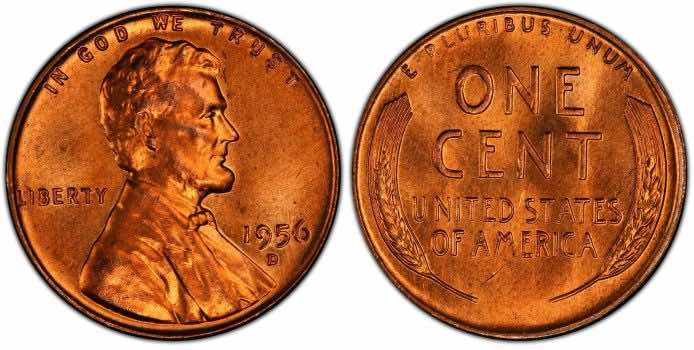Ed. note: This article is periodically updated to reflect the current price of most valuable coins.
In Coleccionistas de Monedas, we fight against the misinformation surrounding the world of coins on the Internet. For this reason, our articles are entirely written by people, not AI or other automated systems. Additionally, we link to all sources and references for coin prices, with the goal of providing you with real, updated, and reliable information.
How do we verify coin prices and values?
At Coleccionistas de Monedas, we are committed to providing accurate, trustworthy, and well-sourced numismatic information. We understand that articles about coin values can influence important financial decisions, which is why we apply a clear and rigorous methodology to estimate prices.
Sources used
- PCGS Price Guide: The official pricing guide from the Professional Coin Grading Service.
- NGC Price Guide: Updated valuation system from the Numismatic Guaranty Company.
- Heritage Auctions: Database of real auction sale prices.
- Red Book: Printed guidebook with historical pricing by grade.
- eBay Sold Listings: Only completed sales are considered, not asking prices.
Validation process
- Price review by condition grade using standard scales (MS, AU, XF, VF).
- Verification of varieties and errors through multiple data sources.
- Expert consultation when prices significantly deviate from the norm.
- Regular updates to reflect current market trends.
Important disclaimer
The values presented in this article are for reference purposes only. Final coin prices can vary significantly depending on authenticity, grade, and selling context. We strongly recommend having your coin certified by a professional service such as PCGS or NGC before selling or purchasing it as an investment.
Did you know that there are 1956 D Wheat pennies that can be worth up to $13,200? Here we tell you all the details about these valuable coins and help you find out how much your 1956 pennies are worth.
1956 D Wheat Penny Values
In average condition, below MS, coleccionistasdemonedas.com estimates an average value for the 1956 D Wheat Penny between $1.5 to $3 for Philadelphia, between $1.25 to $2.50 for the Denver and between $12 to $15 for the certified mint states and Philadelphia Proof coins.
JUMP TO SECTION
What is a 1956 D wheat penny?
The Lincoln Head Cent or Wheat Reverse Penny owes its name to the image of President Abraham Lincoln on the obverse facing right and two ears of wheat on the reverse.
In 1909 it began to be produced on the occasion of the anniversary of the birth of Lincoln and since then it has maintained the image of Lincoln on the obverse, being one of the most long-lived representations of the coinage series of the United States of America.
How to identify a 1956 D wheat penny?
The Wheat Reverse Cent remained in design from its inception in 1909 until 1958, then changing its design to the Lincoln Memorial and later the Union Shield to the present day.
Let’s analyze the design of the Lincoln wheat pennies from 1956. Its creator was Victor David Brenner (VDB).
Obverse
Portrait of President Abraham Lincoln looking right. On it the legend “In God We Trust”, to the left the word “Liberty” and to the right the date and under it the mint mark.
Reverse
Two ears of wheat surrounding the value, which appears in the center “ONE CENT”, below “United States of America” and above the legend “E – Pluribus – Unum”.
How much is a 1956-D penny worth today?
In general, a circulated 1956-D penny is worth its face value of one cent. However, if the coin is in uncirculated condition, meaning it has never been used in commerce and retains its original mint luster, it may be worth more to collectors.
According to current pricing information, an uncirculated 1956-D Lincoln Wheat Penny graded MS-63 by a third-party grading service can be around $0.75 to $1.00. If the coin is graded higher, such as MS-65, its value could be about $20 or more. However, it’s important to note that the value of any coin is subject to market fluctuations and can change over time.
Differences between a 1956 D Wheat Penny and today’s Pennies
As for the weight, it should be noted that it remained at 3.11 grams until 1982. The metals that make up a 1956 Wheat Penny are:
- 95% copper and
- 5% tin and zinc
Unlike the 1956 wheat penny, today’s wheat penny weighs only 2.5 grams, and is composed of copper-colored zinc.
On the reverse of the one-cent coins minted between 1909 and 1958, we can see two ears of wheat surrounding the central legend “ONE CENT – UNITED STATES OF AMERICA” as if it were a laurel wreath. Just above this legend, appears the Latin motto “E PLURIBUS UNUM” (From many, one), common on American coins.
What types of 1956 lincoln cents are there?
The 1956 Lincoln Cent was produced at the Philadelphia and Denver mints. Recall that coins produced at the Philadelphia mint do not bear mintmarks and coins produced at Denver feature the capital letter “D” under the date on the obverse.
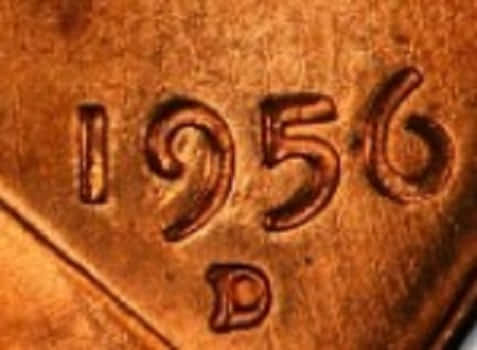
Two types of 1956 Wheat Reverse were produced, the type intended for circulation (“Regular Strike”) which took place at both mints and the type intended for presentation and collection which was produced in special sets (“Proof coins”) and was only produced at the Philadelphia mint.
How rare is a 1956-D wheat penny?
The 1956-D Lincoln Wheat Penny is relatively common and is not considered a key date in the series. The Denver Mint produced 1,098,201,000 Lincoln cents in 1956, and while some coins may be in better condition than others, there are many examples of this coin available to collectors.
However, it’s worth noting that the value of a 1956-D Lincoln Wheat Penny can vary depending on its condition and any unique characteristics, such as errors or varieties. A coin in uncirculated condition or with a rare error can be worth significantly more than a typical circulated example.
How to know the mint of a 1956 D Wheat Penny
It is precisely the spikes that give the wheat penny its name. To know the year of the coin we must look at the obverse. There we can see on the right side of Lincoln’s bust “1956“. Under this number there may or may not be a letter, this is the mint. Above the bust of Lincoln appears another motto, “IN GOD WE TRUST”, and to the left of it, the word “LIBERTY”.
Wheat Penny D Mint Types
The mints are the factories where coins are minted. In the United States, there are three main mints. Philadelphia, Denver, and San Francisco.
To identify the mints on our 1956 D Pennies, just look at the obverse letter above, under the number indicating the year of issue.
- No mint mark: Corresponds to the Philadelphia mint.
- One letter D: Denver mint
- One letter S: San Francisco mint.
There were only two mints that issued the 1956 Wheat Penny: Philadelphia and Denver. If you want to know which of the two mints produced it, you should look at the letter under the year.
How many units were minted?
The quantities minted of each type and at each mint were as follows:
| Regular Strike | Proof | |
| Philadelphia | 420,745,000 | 669,384 |
| Denver | 1,098,201,100 | – |
Before 1956 the Proof special editions had relatively low print runs, remember that in 1942, due to World War II, the production of Proof series was stopped.
In the 50’s the production of special editions in proof quality was resumed and grew exponentially. So much so that in 1955 the number of units produced in proof was 378,200 and in 1956 it almost doubled with the 669,384 units shown in the table above.
In 1957 Lincoln Cents Proof production was 1,247,952 units, in 1961 it reached 3,028,244 units and in 1964 the total number of units produced was 3,950,762.
What is a 1956 D wheat back penny worth?
As we usually repeat in each article dedicated to the Wheat Reverse Cents from coleccionistasdemonedas.com we always recommend to look for high grades (MS) and if possible of Red (RD) tonality, which are usually the most demanded by coin collectors. Within the Lincoln Penny we must establish the classification of shades in Red (RD), Red & Brown (RB) and Brown (BN).
Regarding Proof coins, these are relatively common Red (RD) in high grades, less common in Cameo (Cam) high grades or PR67 and in Deep Cameo (DCam) they would be scarce in almost any grade.
For example, in PR68 CAM quality a 1956 Wheat Reverse Penny was auctioned for $1,840 in 2006 and in DCAM a PR68 from the William Bland Collection fetched $16,100 at auction in 2003.
List of most rare and valuable 1956 wheat penny
The most valuable wheat pennies issued by the United States mint are uncirculated coins in extremely fine condition. If you have one that meets these characteristics, look for it in our list to know its accurate value.
1. 1956 MS67+ RD – $ 57,600
According to PCGS there are only 3 specimens of 1956 Wheat Reverse Penny in extremely fine condition MS67+ RED (RD).
In December 2022, two MS67+RD quality pennies set record sale prices at auctions. One of them reached $57,600, and another was sold for $18,000.
Besides, in June 2021 a PCGS CAC certified specimen was auctioned at Heritage Auctions reaching a value of $13,200, belonging to the GL & SL Stonebarger Collection.
Other remarkable 1956 Wheat Reverse Penny MS67+ RD was another PCGS and CAC certified one belonging to the “High Desert” Collection. It appeared at Heritage Auctions in January 2017 fetching $3,290.
2. 1956 PR68 DCAM – $ 4,320
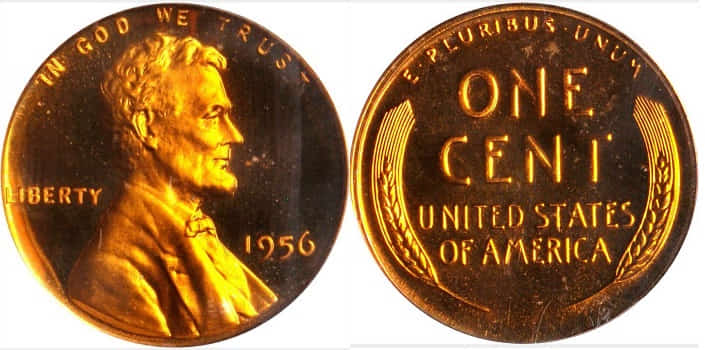
In 2021 we could see at Stack’s Bowers auction house another 1956 Wheat Reverse Penny PR67 DCAM reach $4,320.
Specifically, the specimen came from the Aberg Collection and was auctioned in November 2021.
3. 1956-D/D RPM MS67 RD – $ 1,620
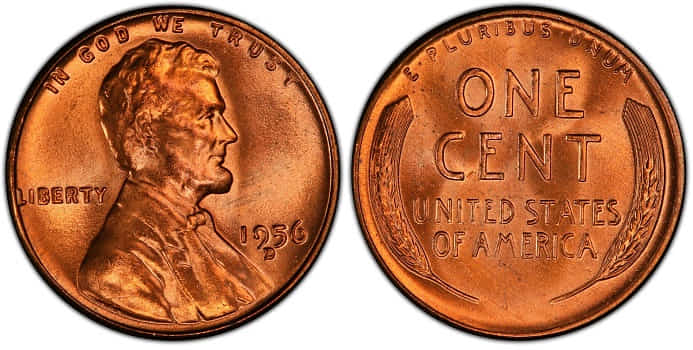
This is a 1956 Wheat Reverse Cent with Repunched Mark (RPM) of the Denver mint initial.
This record-breaking specimen is a CAC specimen that was auctioned in April 2021 and sold for $1,620. PCGS has only 2 specimens in MS67 condition (extremely fine condition), there are no specimens in higher quality.
4. 1956-D MS67+ RD – $ 1,320
This is a GL & SL Stonebarger collection example auctioned on June 22, 2021 that fetched $1,320 (source).
While we take the above example as the most valuable one seen at auction in recent years, there is a 1956-D Wheat Penny MS67 RD from the William Bickel Collection that even in inferior quality fetched $7,475 in July 2005. This is the highest price paid for a 1956 Wheat Penny from the Denver mint.
5. 1956 DDR PR67 RD – $ 780
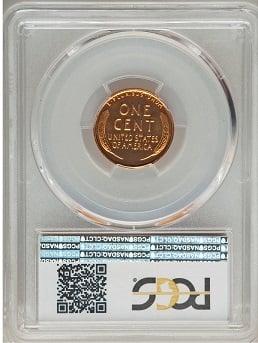
The DD (Double Die) specimens occur when there is a double minting of one or both sides of the coin. In this case there was a double minting of the reverse (Double Die Reverse), visible in some of the letters.
In the case of the 1956 Wheat Cent in August of this year 2021 have been seen a copy DDO RD in PR66 quality at Heritage house auction that was auctioned at $ 360 and another copy of 1956 Wheat Cent DDR RD but graded by PCGS as PR67 that exceeded twice the auction value of the DDO RD PR66.
This 1956 Wheat Cent DDR PR67 RD example is the one shown in the image above (source).
6. 1956 PR68 RD – $ 350
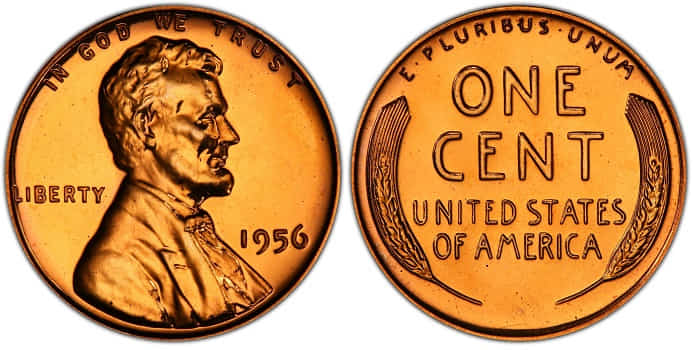
This year 2021, a Proof Red graded PR68 (the same as the one pictured) has been sold for $350.
As previously mentioned, these specimens with Red conservation are the most common and therefore less valued even in high grades such as this PR68.
What is the error on a 1956-D wheat penny? List of main errors
The value of a 1956-D Lincoln Wheat Penny varies depending on its condition, rarity, and other factors such as mint errors or varieties.
There are several known errors or varieties for the 1956-D Lincoln Wheat Penny, but the most significant is the Doubled Die Obverse (DDO) variety.
A Doubled Die Obverse occurs when the design on the coin is struck with the die engraved with a doubled image, creating a noticeable doubling effect on some or all of the elements on the coin’s front side. In the case of the 1956-D Lincoln Wheat Penny DDO variety, the doubling is most prominent on the inscriptions “LIBERTY” and “IN GOD WE TRUST,” as well as on the date.
The 1956-D Doubled Die Obverse variety is considered rare and valuable. It can be worth several hundred to several thousand dollars, depending on its condition and the severity of the doubling. Suppose you think you have a 1956-D Doubled Die Obverse Lincoln Wheat Penny. In that case, it must be evaluated by a reputable coin dealer or third-party grading service to confirm the variety and determine its value.
Like other Lincoln Cents of different dates, the 1956 Lincoln Cents also have mint errors that are highly sought after and valued as they are scarce and also encapsulated by TGP.
Let’s take a look at some error coins that have appeared this year at Heritage Auctions.
Error 1. 1956 Lincoln Cent minted on a 10 Cents coin blank – $1,680
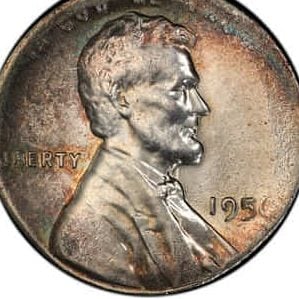
Perhaps the most common error seen at auctions and in the marketplace is the minting of a 1956 Wheat Cent on a coin blanks intended for a 10 Cents coin.
This year we have seen a specimen graded by PCGS as MS63 auction in the $1,680s (the same specimen pictured) and another specimen graded by NGC also at MS63 reach the auction price of $1,560.
Also appearing on a 10 Cents coin blank is a 1956 Wheat Cent from Denver in MS63 by PCGS for $1,440.
Error 2. 1956 Lincoln Cent off center mintage – $228
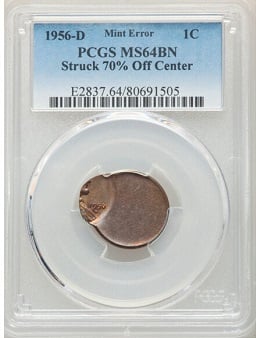
Another minting error of the Wheat Penny is the typical offset mintage, in which the obverse and/or reverse image is offset from the center of the coin blank.
They tend to be less sought-after by coin collectors and investors and therefore less valuable, but they also see some revaluation in the market.
A phenomenon that collectors of errors love is when a coin has been minted incorrectly and the design has been displaced from its original place. This error can be very slight and almost unnoticeable, but in some cases, it can be greater than 50% or even 70% as in the example in the photo.
The value of these errors is difficult to calculate because the percentage of displacement is significant, but in cases like the one in the image, they can exceed $130 even without highlighting for conservation.
An example of this 2021 has been this 1956-D Lincoln Cent PCGS MS64 BN 70 % Off Center. This is a 1956 Denver Lincoln Cent MS64 by PCGS in Brown with a 70 % Off Center mintage that shows the year of mintage and the Denver Mint mintmark.
It was auctioned at $228, and its price is a far cry from the 10 cent coin blank blunders we have seen above.
There are more errors, also less sought after and valuable, such as mintages in fragmented blanks, with laminations,
Error 3. Double D error?
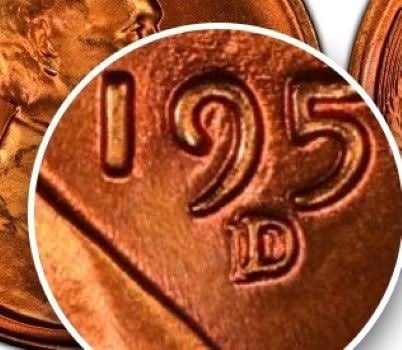
It is a double coinage in the letter indicating the mint (Denver), which as we already know is the letter “D”. We can therefore observe it under the year of the coin, on the obverse.
What does this error imply?
Collectors appreciate any peculiarity in a coin, as it makes it especially rare, and therefore valuable. Combining this feature with good quality, the price can skyrocket.
In the following table we can see the price that the wheat penny can acquire with this error:
| 1956 DD penny Error | MS60 | MS61 | MS62 | MS63 | MS64 | MS65 | MS66 | MS67 |
| Price | $30 | $32 | $35-36 | $45-48 | $80-85 | $100-105 | $150-235 | $1000 |
As you can see, thanks to this error, prices are much higher in any of its grades. Combining the rarity of the error with an extraordinary quality can lead the wheat penny to be worth up to 1000 dollars.
There are of course more errors on the 1956 Wheat Penny minted at the Denver Mint. For example, double mintages exist elsewhere on the coin and although less conspicuous than the double D – they also increase its value:
Error 4. Double Minting in Lincoln
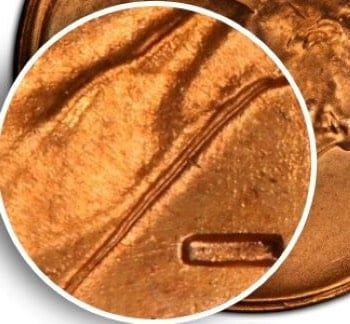
In the image, we can see how the jacket has an “extra” border compared to the normal version. It can also be seen on the nose and other parts of the bust depending on the specimen.
In this table again we can see how the price can go up due to the error:
| D Wheat penny from 1956 “Double Coinage” error | MS63 | MS64 | MS65 | MS66 |
| Price | $75-85 | $125-140 | $200-240 | $450 |
The value of these errors is difficult to calculate because the percentage of displacement is significant, but in cases like the one in the image, they can exceed $130 even without highlighting for conservation.
Conclusion: Why collect 1956 D Wheat Pennies?
As we said at the beginning, pennies are one of the most collected American coins in the world, and this is due to several factors.
- They are generally unexpensive: they are abundant, so if we do not demand quality, it will be easy to find the wheat penny we are missing.
- Good initiation into numismatics: due to the previous factor and added to the great bibliography that exists on them, it can be a good idea to start with these coins on your own or with your children to forge a collection.
So, what are you waiting for to start with a 1956 D Wheat penny collection?
Here’s a quick recap of 1956 D Wheat penny value.
In average condition, below MS, coleccionistasdemonedas.com estimates an average value for the 1956 Wheat Penny between $1.5 to $3 for Philadelphia, between $1.25 to $2.50 for the Denver and between $12 to $15 for the mint states and Philadelphia Proof coins.
References and sources
- Heritage Auctions, “What’s My Coin Worth?, https://coins.ha.com/ref/price-guide.zx”
- NGC Coins, “NGC Price Guide, https://www.ngccoin.com/price-guide/united-states/”
- The Official Red book 2025, “A Guide Book of United States Coins, https://g.co/kgs/8TcE3yq”
- Wikipedia, «List of most expensive coins, https://en.wikipedia.org/wiki/List_of_most_expensive_coins»
- Yahoo Finance, «9 Rare American Coins That Are Worth a Lot of Money, https://finance.yahoo.com/news/9-rare-american-coins-worth-120155095.html»

